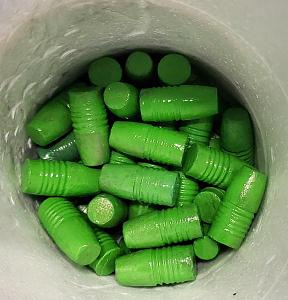Note: Adjust the numbers as needed for actual dimensions.
Looking at that bullet in the case, you might want to push it in just a little more if you are shooting without a gas check.
Ok, so lets say you go for a 2.08" for your AOL.
Lets say your case length is 1.600"
So this works out to 2.08 - 1.600 = 0.420" exposed bullet.
The drawing of your bullet says 0.773" for length (it will be different with / without check).
So this works out to a seating depth of 0.773 - 0.420 = 0.293"
At an AOL of 0.208", 100% fill is when powder fills up the case to 0.293" below the mouth.
And 90% of the above is a good starting load.
For my 200 gr loads, my notes say I stopped at 22.1 gr of WC 680. I was seating deeper than the above.
I ran Quickload based on the estimated numbers above. Note that some of the calculated pressures go well above the SAAMI 40,000 psi limit. This is ok for your gun, but would not be recommended for all guns.
Code:
Cartridge : .357 Maximum (SAAMI)
Bullet : .358, 195 gr x 0.773”
Seating depth : .293 inch
Cartridge O.A.L. L6: 2.080 inch = 52.83 mm
Barrel Length : 14.0 inch = 355.6 mm
Powder : Accurate 1680
Predicted data by increasing and decreasing the given charge,
incremented in steps of 0.8% of nominal charge.
CAUTION: Figures exceed maximum and minimum recommended loads !
Step Fill. Charge Vel. Energy Pmax Pmuz Prop.Burnt B_Time
% % Grains fps ft.lbs psi psi % ms
-08.2 89 22.40 1622 1139 29546 4536 81.3 1.097
-07.4 90 22.60 1638 1162 30387 4593 81.9 1.084
-06.6 91 22.80 1654 1184 31253 4649 82.4 1.071
-05.7 91 23.00 1669 1207 32144 4705 82.9 1.058
-04.9 92 23.20 1685 1229 33059 4761 83.4 1.045
-04.1 93 23.40 1701 1252 34005 4817 83.9 1.032
-03.3 94 23.60 1717 1276 34971 4872 84.4 1.020
-02.5 94 23.80 1732 1299 35979 4926 84.9 1.007
-01.6 95 24.00 1748 1323 37010 4980 85.4 0.995
-00.8 96 24.20 1764 1348 38072 5033 85.8 0.983
+00.0 97 24.40 1780 1372 39165 5087 86.3 0.971
+00.8 98 24.60 1796 1397 40295 5139 86.8 0.960
+01.6 98 24.80 1812 1422 41458 5191 87.2 0.948
+02.5 99 25.00 1828 1447 42655 5242 87.7 0.937
+03.3 100 25.20 1844 1472 43895 5292 88.1 0.926
+04.1 101 25.40 1860 1498 45171 5342 88.5 0.915















 Reply With Quote
Reply With Quote






